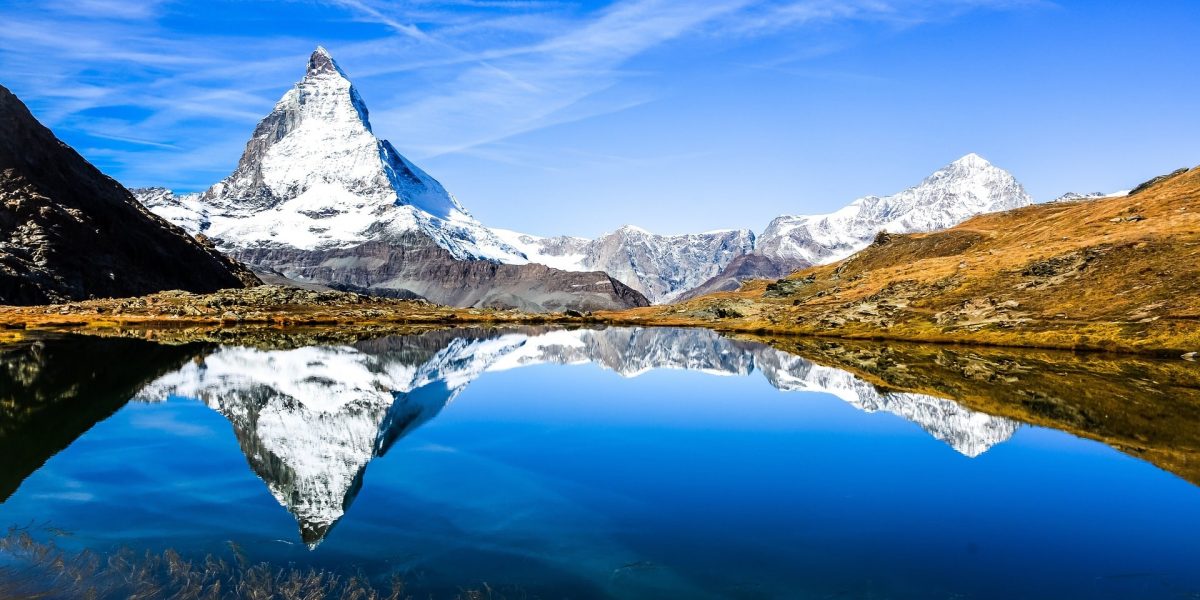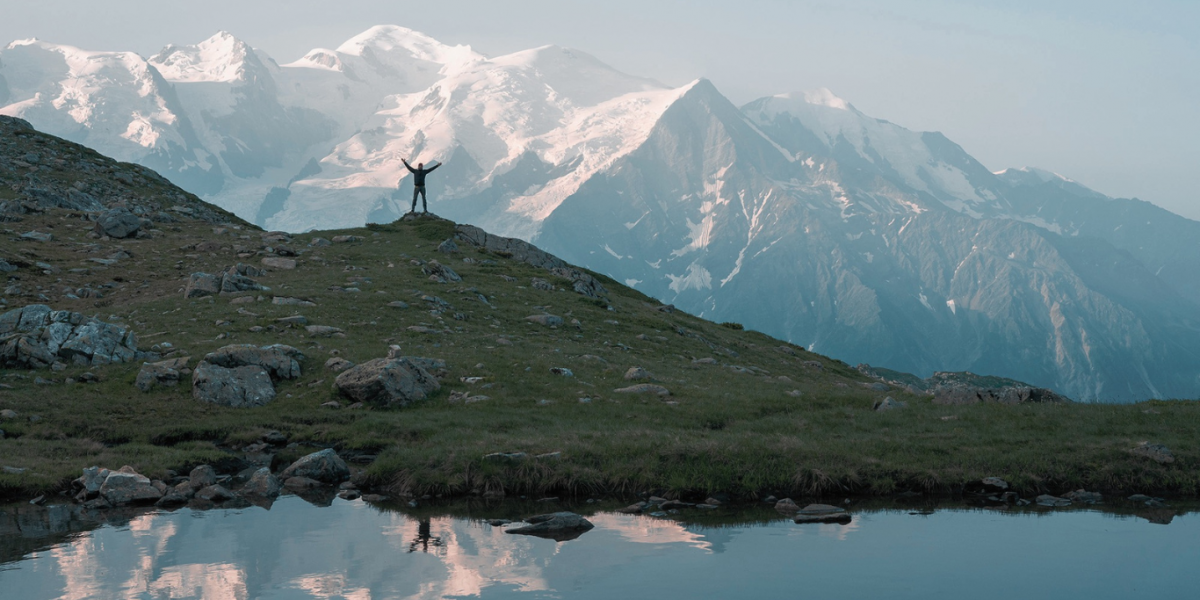CHAMONIX - ZERMATT: Haute Route
Chamonix – Zermatt : Haute Route
ALL YOU NEED TO KNOW ABOUT THE CROSSING BY THE TRAILS
Chamonix – Zermatt
When people think of “Chamonix – Zermatt”, they often know of the glaciaire Haute Route. But there’s another, mid-mountain itinerary! This is the “trail version”: a trek at over varied, non-glacial terrain.
Chamonix - Zermatt : table of contents

📸 The Matterhorn and Lake Riffel, above Zermatt.
Chamonix – Zermatt: the Haute Route of the Alps is a crossing to do! Indeed, this trek is considered one of the most beautiful in Europe.
It links two of the world’s high-altitude capitals: Chamonix and Zermatt.
Chamonix is in the French Alps, at the foot of the giant Mont Blanc. The village culminates at an altitude of 1035 m. Some of the narrow streets take us back to the days when pioneering mountaineers set out to conquer the mountains. The village center comes alive with terraces, stores and restaurants, making it the ideal starting point for hiking, paragliding, mountain biking and more.
Zermatt is in Switzerland, at the foot of the Matterhorn, that emblematic peak with its impressive pyramid shape! It’s a village at an altitude of 1600m. All the streets are pedestrianized. Here you’ll find prestigious shops, lively restaurants and luxury hotels, as well as authentic little streets with old wooden chalets weathered by time.
All the most beautiful scenery in the Alps seems to have been gathered for this trek. Along the way, you can admire the Mont Blanc and the Matterhorn. But also the Grand Combin, the Weisshorn and the Mischabels!
Take the Chamonix-Zermatt by the trail is a travel through a succession of authentic valleys. It’s an opportunity to discover authentic little villages with a certain charm, numerous glaciers, lakes and torrents tumbling down the slopes of shady forests! A jewel box of wonders.

The Chamonix – Zermatt by trail and the Tour du Mont-Blanc are two long-distance hiking itineraries, both on mountain ranges subject to the same constraints and dynamics. The mountain environment (ecosystem, weather/climate, relief and landscape…) has the same characteristics. These two hikes are therefore equally beautiful. In our opinion, here are two points to help you make your choice.
- The large number of visitors to the TMB has encouraged the formation of a wider trail. The path is much “smoother” and more comfortable, thanks to the passage of hikers, mountain bikers and animals. What’s more, the Chamonix-Zermatt itinerary features more technical sections of the route (crossing the Grand Désert, for example).
- The Chamonix-Zermatt trails cross passes that are higher in altitude. The physical effort is therefore more demanding, and the climatic constraints potentially more intense.
- The Chamonix-Zermatt offers much greater daily vertical drops and total distance covered. Managing effort and recovery times requires more experience.
The Tour du Mont Blanc:
🕞 Duration: 6 to 11 days approx.
🏔️ Total ascent: 10,000 m of cumulative ascent on average*.
🥾 Distance: 170 km on average*.
🥵 Difficulty: we estimate the difficulty level of the Tour du Mont-Blanc to be “elementary”.
🌤 Recommended period: mid-June to early September.
➡️ The Chamonix – Zermatt is much less popular than the Tour du Mont Blanc:
- Doing the Chamonix – Zermatt by trail is a much better way to enjoy the solitude of the great outdoors. The Tour du Mont-Blanc (TMB) is France’s most famous long-distance hiking route (GR TMB). It has an ever-growing international reputation and is covered by 25,000 hikers every summer.
The Chamonix – Zermatt, by the trails:
🕞 Duration: 7 to 14 days approx.
🏔️ Total ascent: 14,000 m of cumulative ascent on average*.
🥾 Distance: 225 km on average*.
🥵 Difficulty: we estimate the difficulty level of the Tour du Mont-Blanc to be “expert”.
🌤Recommended period: mid-June to September.
Discover our itinerary to Chamonix from Zermatt here 📍and a blog post about the day-by-day crossing written by one of our customers!
The classic route is 225 km long. It crosses the heart of the Alps on both the French and Swiss sides. The French section is shorter: just 20 km or so before crossing the border at the Col de Balme. The view of Mont Blanc is magnificent!
You’ll find marked trails, passes and numerous valleys, villages and refuges. The route avoids glaciers and the highest peaks. The highest culminating point is around 3OOOm. There are many variants for the crossing. Depending on the itinerary chosen, you should allow between 7 and 14 days. No special technical equipment is required (crampons, ice axes, etc.).
Some variants shorten or lengthen the path:
You can reduce your walking time by using public transport (bus or train in the valley, or lift in the resort).
- It is possible to avoid the first part of the route, which passes through the TMB, and do the Chamonix – Zermatt in 7 days.
Most of the stages end at the bottom of the valley, directly accessible by bus or train. So it’s easy to split this trek into several parts
There are many topo-guides available to help you choose the route you want to take. The maps are well-detailed and all variants are clearly indicated.
For equipment, you will need:
- Good hiking shoes.The path is long, unstable and rocky.
- A first-aid kit with antiseptic, bandages, etc.
- Equipment for eating and drinking between refuge stops, water filter, eventually.
- When it comes to clothing, you’ll need to bring something for “all seasons“!
In terms of physical condition, in theory, this trek is accessible to any hiker in good physical condition and health; to any hiker who is already familiar with trekking. But, the crossing is demanding.
There are 3 reasons for this:
- The route is particularly long: around 225 km to cover.
- The difference in altitude is considerable. Each day, you’ll have to climb to a new pass, then descend to a new valley. There are more than 9 passes to cross. All in all, the total vertical drop is 14,000 m, which is no mean feat!
- You can suffer from a lack of oxygen at altitude, even at 3000m (highest point): the altitude sickness.
You’ll need to be able to walk 20 km a day, with an average gradient of 1000 m, and then repeat the effort the next day. So it’s essential to be well prepared physically and mentally, and to be properly equipped.
To help you prepare physically, you can :
- Carry out day outings offering an equivalent or more demanding level of difficulty.
- Increase the number of experiences that reinforce your skills and abilities (diversify practice environments, modes and techniques).
Encourage the acquisition of new skills (map reading, compass or GPS navigation, for example).
Before you set off, it’s important to plan your trek. What’s more, you’ll need to plan early:
- The route you will take, of course, but also the accommodation you will choosen. Accommodation on the Chamonix – Zermatt route can be in mountain huts (please note that camping/bivouac permits are required. In mid-mountain areas, bivouacs are tolerated in France, and authorized in Valle d’Aosta above 2500m. It is forbidden throughout Switzerland). Or you can camp, stay in a hotel or rent an apartment in the valley. Mountain refuges are generally open from early June to late September. We advise you not to delay booking your accommodation, especially from mid-July to mid-August, when the weather, temperatures and trail conditions are most favorable.
- The time of year to go: it will determine your equipment list! It’s worth noting that the peak season is from mid-July to mid-August. However, not all hikers do the Chamonix-Zermatt trek. There are also other treks that share some sections of the same route (such as the Tour du Mont Blanc or the Matterhorn tour). June and September are quieter periods; the trails remains passable, but the refuges are not always open. The main problem at this time of year is the presence of snow on the passes. In some years, the passes are impassable until the end of June! So you’ll need to be prepared or equipped accordingly.
Once you’ve defined your route, your level of autonomy and the time of year you’d like to leave, you can start your equipment list accordingly!
Don’t hesitate to call on us! We’ll take care of the entire organization of yourChamonix – Zermatt 🙂

It’s the outdoor spaces and especially the desire to share them that led us to create the agency in 2019.
Our primary goal is to help you make the most of the extraordinary experience the mountains have to offer. Whether you’re looking to recharge your batteries or challenge yourself physically, we’ve got an activity just for you!
With passion, sharing and confidence 🏔️
